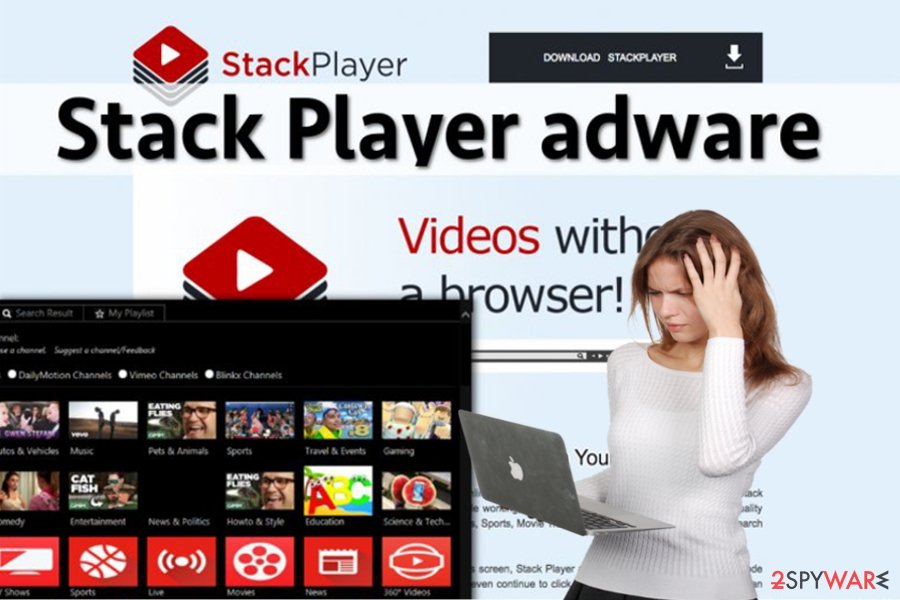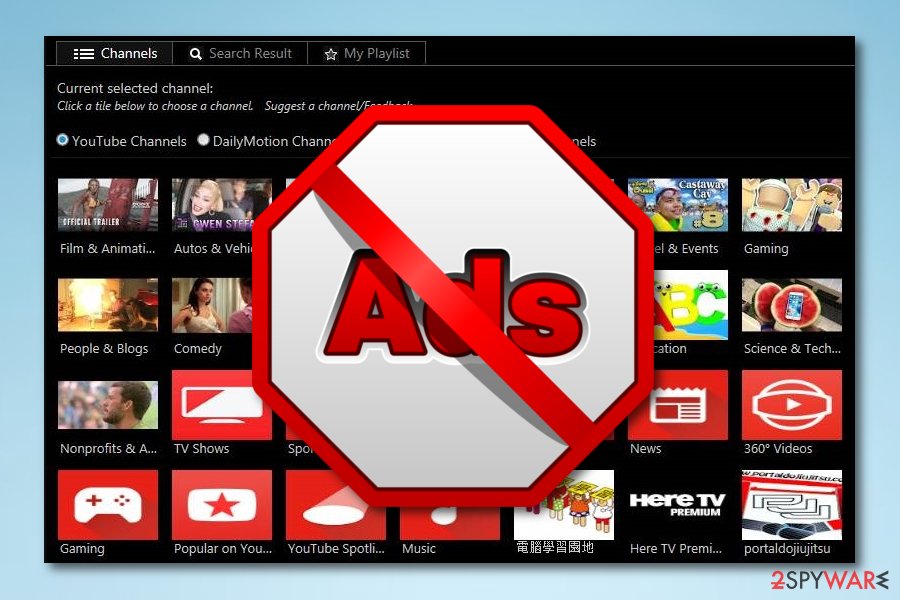Stack Player ads (spam) - 2021 update
Stack Player ads Removal Guide
What is Stack Player ads?
Stack Player is the PUP that leads to various annoying advertisements coming to your screen directly

Stack Player is a potentially unwanted program claiming to help users watch their favorite videos without a browser. However, next to its seemingly convenient functionality to stream videos, this potentially unwanted program can also track your searches. Moreover, you can call this PUP an adware-related program as it might display numerous unwanted ads on your computer screen while you perform browsing activity.
If you spot that your browser's homepage was modified without your permission, frequent dubious redirecting, or an increased amount of ads, you should get rid of Stack Player virus permanently before it causes any serious damage like taking you to a virus-related website.
| Name | StackPlayer |
|---|---|
| Category | Adware |
| Sub-category | PUP |
| Similar to | NowUSeeIt player, Playthru player |
| Ad types | Pop-ups, pop-unders, coupons, banners, sale posts, etc. |
| Possible damage | This adware-related app can take you to potentially dangerous websites where you can secretly install a virus on your machine |
| Distribution techniques | Bundled programs that you download from free Internet sources, dubious-looking websites you might have entered |
| Prevention tips | Do not skip any downloading/installing steps, stay away from suspicious web pages, use anti-malware tools to protect the computer system automatically |
| Elimination | Try to delete the PUP by installing and running anti-malware software |
| Recovery | You can restore functions and features altered y the PUP with a tool like FortectIntego |
StackPlayer virus has also been praised as an alternative for Adobe Flash Player[1] but the latest tests have revealed that its functionality is much more similar to NowUSeeIt player or Playthru player which have already been included in the list of PUPs. All that they do is display sponsored content and redirect people to predetermined websites. Nevertheless, such redirects can take users to potentially dangerous web pages which might be filled with hazardous content.
However, the main problem caused by this ad-supported program is its sponsored pop-up ads that are displayed as soon as you open your browser. Usually, its victims report annoying warning messages, ads,[2] and links in their search results. Unfortunately, these ads can ruin your happiness as they might often pop out while you are surfing the Internet which might relate to regular browser slowdowns. So, according to security experts from NoVirus.uk,[3] you need to remove the virus to avoid annoying advertising
The reason why Stack Player keeps pushing these ads for its users is very simple – its developers are seeking to get a chance to earn the money thru the pay-per-click scheme.[4] Pay-per-click advertising model is a very efficient way to earn money by promoting certain websites and their products. However, these websites are not monitored in the way that they should, so you can end up on an insecure web page.
Therefore, if you do not approve or do not want to take part in such shady means of making money, you should perform the threat removal from Windows 10 or any other operating system. You can use reputable antivirus tools, such as SpyHunter 5Combo Cleaner, Malwarebytes to assist you in the removal procedure of this adware. However, if you prefer to take care of the elimination manually, take a look at our offered instructions which you can find below this article. Make sure you complete each step with a big care.

Modus operandi of the virus
The annoying virus can get into the system with or without your approval. Usually, it hijacks computers without users' knowledge with the help of bundling. This method can join two or more different programs into one and you can spot the potential danger only if you monitor freeware's installation process.
In such a case, annoying and intrusive ads start appearing on your computer's desktop every time you perform researches on the web. No matter how appealing they look, you should be aware of the fact that clicking on such advertisements may be dangerous as they are created to look attractive to trick users into clicking on them.
Keep in mind that “Ads by [name of adware]”, “Powered by [name of adware]” and other ads featuring similar slogans are not the same as regular advertisements. Adware causes pop-ups, banners, and in-text ads with the aim to redirect you to some suspicious sites which are seeking to increase, sales, the number of their visitors, or even infect you with malware.
In addition, StackPlayer can also be used for tracking! After installing cookies[5] on your web browser it gets an opportunity to collect non-personal information about its victims.[6] The collected data is additionally used to generate ads that are pre-selected according to your interests and habits. This way, ads become more appealing, and the users are more likely to click on them, consequently, bringing more profit to the adware creators.
Finally, we should warn you that gathered information is not protected in any way. It can be shared with unreliable third parties or sold for commercial purposes. So, if you are not considering installing a virus removal tool just yet, we advise you to think carefully about whether you want to share information with unknown third parties or not. If not, make sure you get rid of the annoying app from your computer.

Core distribution principles used to promote third-party adware
Sadly, but the infiltration of adware programs[7] is a very common issue reported by users. One of the main causes of the rapid spreading of these types of viruses is neglectful software installation. To install software correctly, you should follow these simple guidelines:
- Don't hurry to install the downloaded freeware or shareware. These programs often become the carriers of potentially unwanted content.
- Find out whether you have downloaded a software package with a malicious addition to it. To do that, you should always use the “Advanced” installation settings and follow all the steps carefully. If the software package contains some additional components, you will be able to see what they are and cancel their installation if something seems suspicious.
- Equip your system with antivirus and anti-malware tools. This software will provide your computer with some extra protection and prevent you from obtaining potentially malicious programs.
Learn ways to remove the Stack Player virus

To uninstall the virus from your computer, you need to either get rid of all components of this adware or use an updated anti-spyware program to do this task for you. Each of these methods is considered safe and effective. However, those who don't have tech-related knowledge should stick to the second removal option.
As you have probably learned, closing pop-up ads cannot help you get rid of Stack Player and similar adware because you need to find the cause of these ads, i.e.: the adware components that are generating them on your browser. This might be a rather complicated task because such potentially unwanted programs tend to hide in the system, and you cannot easily find them.
Luckily, there are tools created specifically for this purpose. You will simply need to download a reputable anti-malware software that will automatically scan your system and remove this or any found virus and entries that are related to it from your infected device. Remember that for the most effective virus elimination, you should update the anti-malware suite to its latest version.

You may remove virus damage with a help of FortectIntego. SpyHunter 5Combo Cleaner and Malwarebytes are recommended to detect potentially unwanted programs and viruses with all their files and registry entries that are related to them.
Getting rid of Stack Player ads. Follow these steps
Uninstall from Windows
Instructions for Windows 10/8 machines:
- Enter Control Panel into Windows search box and hit Enter or click on the search result.
- Under Programs, select Uninstall a program.

- From the list, find the entry of the suspicious program.
- Right-click on the application and select Uninstall.
- If User Account Control shows up, click Yes.
- Wait till uninstallation process is complete and click OK.

If you are Windows 7/XP user, proceed with the following instructions:
- Click on Windows Start > Control Panel located on the right pane (if you are Windows XP user, click on Add/Remove Programs).
- In Control Panel, select Programs > Uninstall a program.

- Pick the unwanted application by clicking on it once.
- At the top, click Uninstall/Change.
- In the confirmation prompt, pick Yes.
- Click OK once the removal process is finished.
Delete from macOS
Remove items from Applications folder:
- From the menu bar, select Go > Applications.
- In the Applications folder, look for all related entries.
- Click on the app and drag it to Trash (or right-click and pick Move to Trash)

To fully remove an unwanted app, you need to access Application Support, LaunchAgents, and LaunchDaemons folders and delete relevant files:
- Select Go > Go to Folder.
- Enter /Library/Application Support and click Go or press Enter.
- In the Application Support folder, look for any dubious entries and then delete them.
- Now enter /Library/LaunchAgents and /Library/LaunchDaemons folders the same way and terminate all the related .plist files.

Remove from Microsoft Edge
Delete unwanted extensions from MS Edge:
- Select Menu (three horizontal dots at the top-right of the browser window) and pick Extensions.
- From the list, pick the extension and click on the Gear icon.
- Click on Uninstall at the bottom.

Clear cookies and other browser data:
- Click on the Menu (three horizontal dots at the top-right of the browser window) and select Privacy & security.
- Under Clear browsing data, pick Choose what to clear.
- Select everything (apart from passwords, although you might want to include Media licenses as well, if applicable) and click on Clear.

Restore new tab and homepage settings:
- Click the menu icon and choose Settings.
- Then find On startup section.
- Click Disable if you found any suspicious domain.
Reset MS Edge if the above steps did not work:
- Press on Ctrl + Shift + Esc to open Task Manager.
- Click on More details arrow at the bottom of the window.
- Select Details tab.
- Now scroll down and locate every entry with Microsoft Edge name in it. Right-click on each of them and select End Task to stop MS Edge from running.

If this solution failed to help you, you need to use an advanced Edge reset method. Note that you need to backup your data before proceeding.
- Find the following folder on your computer: C:\\Users\\%username%\\AppData\\Local\\Packages\\Microsoft.MicrosoftEdge_8wekyb3d8bbwe.
- Press Ctrl + A on your keyboard to select all folders.
- Right-click on them and pick Delete

- Now right-click on the Start button and pick Windows PowerShell (Admin).
- When the new window opens, copy and paste the following command, and then press Enter:
Get-AppXPackage -AllUsers -Name Microsoft.MicrosoftEdge | Foreach {Add-AppxPackage -DisableDevelopmentMode -Register “$($_.InstallLocation)\\AppXManifest.xml” -Verbose

Instructions for Chromium-based Edge
Delete extensions from MS Edge (Chromium):
- Open Edge and click select Settings > Extensions.
- Delete unwanted extensions by clicking Remove.

Clear cache and site data:
- Click on Menu and go to Settings.
- Select Privacy, search and services.
- Under Clear browsing data, pick Choose what to clear.
- Under Time range, pick All time.
- Select Clear now.

Reset Chromium-based MS Edge:
- Click on Menu and select Settings.
- On the left side, pick Reset settings.
- Select Restore settings to their default values.
- Confirm with Reset.

Remove from Mozilla Firefox (FF)
Remove dangerous extensions:
- Open Mozilla Firefox browser and click on the Menu (three horizontal lines at the top-right of the window).
- Select Add-ons.
- In here, select unwanted plugin and click Remove.

Reset the homepage:
- Click three horizontal lines at the top right corner to open the menu.
- Choose Options.
- Under Home options, enter your preferred site that will open every time you newly open the Mozilla Firefox.
Clear cookies and site data:
- Click Menu and pick Settings.
- Go to Privacy & Security section.
- Scroll down to locate Cookies and Site Data.
- Click on Clear Data…
- Select Cookies and Site Data, as well as Cached Web Content and press Clear.

Reset Mozilla Firefox
If clearing the browser as explained above did not help, reset Mozilla Firefox:
- Open Mozilla Firefox browser and click the Menu.
- Go to Help and then choose Troubleshooting Information.

- Under Give Firefox a tune up section, click on Refresh Firefox…
- Once the pop-up shows up, confirm the action by pressing on Refresh Firefox.

Remove from Google Chrome
Delete malicious extensions from Google Chrome:
- Open Google Chrome, click on the Menu (three vertical dots at the top-right corner) and select More tools > Extensions.
- In the newly opened window, you will see all the installed extensions. Uninstall all the suspicious plugins that might be related to the unwanted program by clicking Remove.

Clear cache and web data from Chrome:
- Click on Menu and pick Settings.
- Under Privacy and security, select Clear browsing data.
- Select Browsing history, Cookies and other site data, as well as Cached images and files.
- Click Clear data.

Change your homepage:
- Click menu and choose Settings.
- Look for a suspicious site in the On startup section.
- Click on Open a specific or set of pages and click on three dots to find the Remove option.
Reset Google Chrome:
If the previous methods did not help you, reset Google Chrome to eliminate all the unwanted components:
- Click on Menu and select Settings.
- In the Settings, scroll down and click Advanced.
- Scroll down and locate Reset and clean up section.
- Now click Restore settings to their original defaults.
- Confirm with Reset settings.

Delete from Safari
Remove unwanted extensions from Safari:
- Click Safari > Preferences…
- In the new window, pick Extensions.
- Select the unwanted extension and select Uninstall.

Clear cookies and other website data from Safari:
- Click Safari > Clear History…
- From the drop-down menu under Clear, pick all history.
- Confirm with Clear History.

Reset Safari if the above-mentioned steps did not help you:
- Click Safari > Preferences…
- Go to Advanced tab.
- Tick the Show Develop menu in menu bar.
- From the menu bar, click Develop, and then select Empty Caches.

After uninstalling this potentially unwanted program (PUP) and fixing each of your web browsers, we recommend you to scan your PC system with a reputable anti-spyware. This will help you to get rid of Stack Player registry traces and will also identify related parasites or possible malware infections on your computer. For that you can use our top-rated malware remover: FortectIntego, SpyHunter 5Combo Cleaner or Malwarebytes.
How to prevent from getting adware
Stream videos without limitations, no matter where you are
There are multiple parties that could find out almost anything about you by checking your online activity. While this is highly unlikely, advertisers and tech companies are constantly tracking you online. The first step to privacy should be a secure browser that focuses on tracker reduction to a minimum.
Even if you employ a secure browser, you will not be able to access websites that are restricted due to local government laws or other reasons. In other words, you may not be able to stream Disney+ or US-based Netflix in some countries. To bypass these restrictions, you can employ a powerful Private Internet Access VPN, which provides dedicated servers for torrenting and streaming, not slowing you down in the process.
Data backups are important – recover your lost files
Ransomware is one of the biggest threats to personal data. Once it is executed on a machine, it launches a sophisticated encryption algorithm that locks all your files, although it does not destroy them. The most common misconception is that anti-malware software can return files to their previous states. This is not true, however, and data remains locked after the malicious payload is deleted.
While regular data backups are the only secure method to recover your files after a ransomware attack, tools such as Data Recovery Pro can also be effective and restore at least some of your lost data.
- ^ Adobe Flash Player. Adobe Creative Cloud. Software and Services.
- ^ STACK PLAYER REMOVAL. Microsoft cummunity. Questions and answers.
- ^ NoVirus.uk. NoVirus. Spyware website and malware removal guide.
- ^ What is Pay-per-click?. Wikipedia, the free encyclopedia.
- ^ Tracking cookie. Symantec. Security Response.
- ^ Are Cookies Dangerous?. Addedbytes blog.
- ^ Margaret Rouse. Adware. Search Security. Tech Target.























